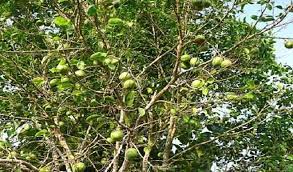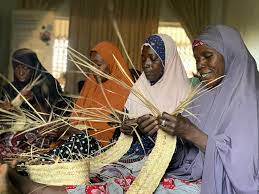
Ogbono plants are mostly grown for their nuts, the fruit is like mango, oval in shape and can be eaten same way. Their juice is used in the production of jams, wine, jelly, etc. Ogbono is used for soup more than other drawing soup. This a kind of soup that is so loved by many, it has great taste and amazing flavour. That’s one of the reasons ogbono demand is always on the increase.
The scientific name is irvingia gabonensis, English name is African mango, wild mango or bush mango. Ogbono grows naturally in the wild and the fruits fall on their own when the matures. The fruits are then allowed to decay or eaten for the seeds that are broken for the nut.
There are different varieties of ogbono in Nigeria; the draw and the non draw type.
Ogbono farming, also known as African mango or bush mango farming, is a lucrative agricultural venture in Nigeria. The demand for ogbono seeds (Irvingia gabonensis) both locally and internationally has created a significant opportunity for entrepreneurs and farmers to tap into this profitable sector.
This article aims to provide a comprehensive guide on how to start an ogbono farming business in Nigeria, covering various aspects such as land selection, seedling acquisition, cultivation practices, harvesting, processing, and marketing strategies.
Market Research and Planning
Before venturing into ogbono farming, it is crucial to conduct thorough market research to gain insight into the demand and potential profitability of the business. Identify potential buyers, such as local markets, wholesalers, exporters, and food processing companies. Determine the prevailing market prices and understand consumer preferences. This research will help you develop a viable business plan and make informed decisions.
Land Selection and Preparation
Selecting suitable land is essential for the success of your ogbono farm. Look for fertile soil with good drainage capabilities and access to a water source. The land should receive adequate sunlight as ogbono trees thrive in full sun or partial shade. Prepare the land by clearing weeds, rocks, and debris. Plowing or tilling the soil will help improve its structure and fertility. Conduct soil tests to determine the pH level and nutrient content and make necessary amendments accordingly.
Seedling Acquisition and Planting
Procure high-quality ogbono seedlings from reliable nurseries or reputable sources. Opt for healthy, disease-free seedlings with a good growth potential.
It can be propagated through seeds and grafting, marcoting, cutting, air layering and budding. But propagation through seed is difficult and may likely fail except you are well experience or have a technical know how on how to go about it.
Plant the seedlings during the rainy season to provide them with sufficient moisture. Dig holes of appropriate size (around 50cm deep and wide) and plant the seedlings, spacing them at least 8-10 meters apart. Ensure the seedlings are well-watered after planting.
Cultivation Practices
Maintaining proper cultivation practices is crucial for the healthy growth and development of ogbono trees. Consider the following practices:
a. Irrigation: Provide regular irrigation during the dry season, especially in the early stages of growth.
b. Weed Control: Implement effective weed control measures to prevent weed competition and maintain optimum plant growth.
c. Fertilization: Apply organic or inorganic fertilizers to supplement nutrient requirements. Consult with agricultural experts or extension services for appropriate fertilization schedules.
d. Pest and Disease Management: Monitor the plants regularly for signs of pests and diseases. Take appropriate measures such as spraying organic pesticides or seeking professional advice.
Harvesting
Ogbono trees generally start bearing fruits after three to five (3-5) years. It flowers from March-June and has two fruiting seasons; April-July and September-October. The fruit is greenish when ripe with a bright orange pulp. It can be harvested by plucking the fruits manually by hand.
Ogbono yield is determined by; the size management of trees, the kind and amount of fertilizer used and finally, the labour applied. Processing of the seed has been a very big challenged but NIHORT has produced nut cutter that can easily cut the shell. And the seeds will come out neat and fast.
The fruits resemble mangoes and turn yellow or orange when ripe. Harvest the fruits when they are fully ripe but not overripe, as overripe fruits may affect seed quality. Collect the fruits from the ground or use poles to shake the tree gently to dislodge them. Proper handling during harvesting ensures minimal damage to the seeds.
Processing
Processing ogbono seeds involves removing the pulp, drying, and packaging. Follow these steps for processing:
a. Pulp Removal: Cut open the fruit and scoop out the seeds. Separate the seeds from the pulp manually or by washing and sieving.
b. Drying: Spread the seeds in a clean, well-ventilated area or use drying racks. Allow the seeds to dry naturally under shade until their moisture content reduces to around 10%.
c. Packaging: Once the seeds are adequately dried, package them in airtight containers or bags to maintain their quality. Label the packages properly with the necessary information such as weight, grade, and production date.
Marketing and Sales
Develop a robust marketing strategy to sell your ogbono seeds profitably. Consider the following approaches:
a. Local Markets: Sell directly to local markets, wholesalers, or retailers. Develop relationships with potential buyers and offer competitive prices.
b. Export Opportunities: Explore export opportunities by connecting with international traders or exporters. Ensure compliance with export regulations and quality standards.
c. Value Addition: Consider adding value to your ogbono seeds by processing them into powder or other products. This can increase profitability and open up new market segments.
d. Online Presence: Establish an online presence through social media platforms or a website to showcase your products and attract potential customers.
Health Benefits of Ogbono
It is high in protein, fibre and essential fats
Ogbono provided calories which are rich in fatty acids and are essential in performing many body functions such as;; strengthening the nervous system, muscles and ligament.
The oil from ogbono seeds are rich in beta-carotene which is powerful in protecting the body against heartburn, high blood pressure, infertility, cancer, mental disorders etc.
The seeds are very helpful in achieving weight lost.
It is used for cardiovascular health and enhances immune.
The bark of ogbono tree is a good remedy for relieving pain.
It promotes libido, improves sleep and memory.
Ogbono contains anti-oxidant, anti bacterial and anti-inflamatory analgesic.
Other uses of Ogbono are
The oil can be used for soap or cosmetics
For margarine used in cooking
Their wood is very hard and can be used in construction such as ship deck making, railway ties etc. The wood is also good in charcoal production.
The pulp is used in the production of black dye
Conclusion
Starting an ogbono farming business in Nigeria requires careful planning, proper cultivation practices, efficient processing, and effective marketing strategies. By following the steps outlined in this comprehensive guide, aspiring entrepreneurs can tap into the lucrative market and maximize their chances of success.
Embrace the opportunities presented by ogbono farming, contribute to the agricultural sector, and capitalize on the increasing demand for this valuable commodity.






















